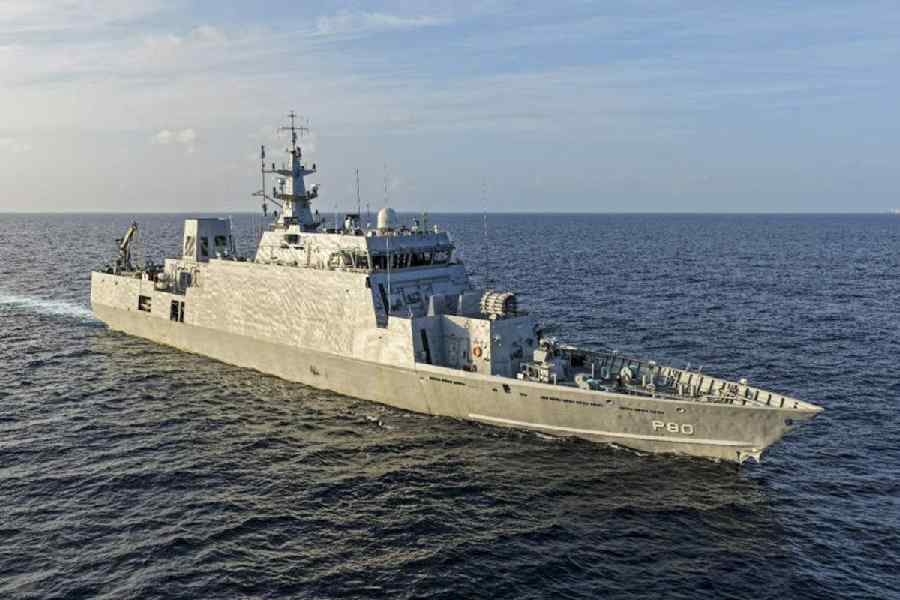PS Bhopal had been lying in a dilapidated condition without its own propulsion system for years at No. 22 Kidderpore Dock of Calcutta. The vessel was commissioned by Calcutta-based steam navigation companies Inland General Navigation and Royal Steam Navigation, and built in 1945 by William Denny & Bros at a shipyard in Dumbarton, Scotland. The 63-metre-long and 9.2-metre-broad vessel was designed to negotiate the shallow waters of Indian rivers. In the recent past, though, it was being used as a training vessel for cadets of the Syamaprasad Mookerjee Port Trust (SMPT), Calcutta.
Most paddle steamers at the dock are scrapped and PS Bhopal was going to meet the same fate in 2019 when Vinit Kumar, who was at the time chairman of SMPT, had a eureka moment. He decided to rebuild the ship and use this vessel of a certain pedigree for a spot of heritage tourism.
Kumar, along with SMPT’s heritage consultant Gautam Chakraborty, envisioned PS Bhopal as this moving maritime museum fitted with a small restaurant and a space for assembly for heritage enthusiasts and tourists.
An “expression of interest”, or EOI, was floated and Eastern Navigation Pvt. Ltd (ENPL), an inland water transport and marine infrastructure company, was the pick of the pile. ENPL, led by its director Yashwant Singhee, took up the task in right earnest. It created an offshoot called The Barge Company for this venture. They repaired the paddles, the crankshaft unit, the anchor windlass and so on, spending several crores of rupees. They curated the Riverine Museum in what used to be the boiler room to display to the interested public the history of paddle steamers and their links with River Hooghly, its tributaries and distributaries.
A fortnight ago, PS Bhopal 2.0 or Bengal Paddle, took a group on The Port Heritage Tour, which was essentially an exploration of the Hooghly, the Kidderpore docks, Howrah Bridge and the ghats of the area. The tour was organised by The Ganges Walk, a heritage conservation group run by Atreyee Basak and Poulomee Auddy. Says Basak, “We also explain to tourists the history of the Hooghly, a river that attracted European colonialists, and the evolution of maritime navigation, focusing on steam propulsion.” When it isn’t taking a spin, the Bengal Paddle remains moored to the jetty at Outram Ghat.
Kumar, who assumed charge as boss of Khadi and Village Industries Commission, Mumbai, some months ago, was not present at the inaugural ceremony. But he told The Telegraph, “I wish the Bengal Paddle a bright future in its new avatar. I feel happy that I have played a small role in this unique public-private partnership to revive the heritage of shipping in a port which played an important part in India’s history.”
Rare artefacts including cen-tury-old anchors, a helm or a steering wheel will transport tourists to an era when thousands of girmitiyas or indentured labourers from India’s heartland were hoarded onto cargo ships for Mauritius, West Indies, Fiji and Suriname, never to return.
Chakraborty rattles off the riveting story of paddle steamers that plied through parts of northern India, undivided Bengal and even Assam, and also the tales around the origin and development of paddle steamers. PS Bhopal and its likes were brought down all the way from Scotland, which was the construction hub of paddle steamers propelled by coal power. Coal used to be shoved into the ship’s furnace to produce steam which in turn moved the metallic paddle wheels — 10 feet in diameter — built on either side of the ship. These would then push the ship across the water.
“Paddle steamers played a key role in the transport of cargo, passengers and even the transport of soldiers during the two World Wars,” says Chakraborty. Many were operated by private shipping companies for colonialist traders transporting raw agricultural produce, such as indigo, opium, jute, paddy, mustard seeds and cotton, from India to Britain. The same paddle boats would ferry dhotis and saris manufactured in mills in Manchester and offload them in Indian ports. Some paddle steamers were also built at the Calcutta docks in the 1870s by the Garden Reach Shipbuilders and Engineers (GRSE) and shipbuilders such as the Qidd Brothers.
Paddle steamers — PS Mah-moud, PS Lepcha, PS Ostrich and PS Gazi — had been in use in Bangladesh until recently. Artist Aditya Basak has seen GRSE paddle steamers on the Buriganga river in Dhaka. He says, “Ordinary citizens called them Rocket Steamers. There were multiple decks,and passengers carried loads of gunny sacks and bales in those beautiful vessels.”
According to Chakraborty, coal-powered paddle steamers were converted into diesel-run vessels post-Independence. But later, the ships were modified in such a way that the paddles were turned into showpieces — they stopped revolving — and the vessels operated like usual motor launches, guzzling gallons of fuel.
Paddle steamers, according to experts, still operate in some waterways of the US and Europe. Says Chakraborty, “There are heritage enthusiasts in Britain who are crowdfunding to revive derelict paddle steamers and building one from scratch in the Scottish dockyard through crowdfunding.”
At the moment there are two functioning ships — PS Waverley and PS Kingswear Castle — operated by the Paddle Steamer Preservation Society. The society, a charitable organisation, is also working on the revival of two other paddle steamer projects, PS Maid of the Loch and PS Medway Queen.











